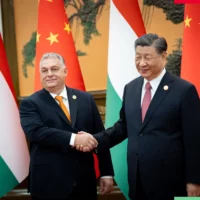Car makers anticipate excess inventory to bring prices down in 2023
Sponsored content
An April 3 report by UBS revealed that car shoppers may see some good news this year. Thanks to an aggressive production schedule that was designed to keep up with demand, the bank anticipates that there will be an excess of 5 million cars hitting the market in the latter half of 2023.
Heavy Production Will Bring Down Car Prices In Late 2023
According to the UBS report, this “glut” of inventory will put downward pressure on the market price of new vehicles, providing some relief for consumers who have seen sky-high prices on dealership lots since the COVID-19 pandemic first began interrupting the supply chain.
“Given the bullish production schedules, we see high risk of overproduction and growing pricing pressure as a result. The price war has already started unfolding in the EV space, and we expect it to spread into the combustion engine segment,” the company said in a note it sent out to clients.
UBS anticipates car production to exceed sales by as much as 6 percent, which would have a significant impact on how much vehicles sell for. Some manufacturers, such as Tesla, have already begun slashing prices in order to ensure that the inventory hitting the market gets sold at an acceptable pace to avoid inventory buildup.
Although prices for vehicles still remain historically high, the average purchase value of a new vehicle has dropped for three months in a row, a trend which could be foreshadowing the price drops to come in the latter half of the year.
Experts were concerned in late 2022 that fears of an impending recession and two years of inflated car prices could lead to “demand destruction,” or a significant fall in the number of people looking to purchase a new vehicle. Coupled with the anticipated oversupply in mid to late 2023, this could result in slashed prices for vehicles hitting the market.
Supply Chain Struggles Upturned Car Market In 2020
Beginning with the COVID-19 pandemic in early 2020, interruptions to the supply chain — particularly interruptions to the microchips that are vital for many modern vehicles today — severely limited the number of vehicles that automakers could put on the market.
The majority of microchips for vehicles at the time of the pandemic were produced in Taiwan and China, where the pandemic began. Severe lockdowns meant that the semiconductor industry necessary for vehicle manufacturing essentially ground to a halt, freezing most manufacturer’s abilities to put out finished products.
As a result, the new car market saw a serious shortage of inventory, requiring dealerships to add major premiums to the manufacturer’s suggested retail price (MSRP) in order to bring in enough profit to stay open.
As much as 10 million cars slated for production were canceled in 2021, and another 4 million slated for production were canceled in 2022, which meant that consumers had an extremely limited supply of inventory to choose from.
Due to the squeeze on the new car market, consumers in need of vehicles turned to the used car market, which soon saw an equally substantial rise in prices. In some instances, consumers saw used and even damaged cars rise in value through the pandemic, instead of the typical pattern of depreciation as a vehicle ages.
Aggressive vehicle production throughout 2022 designed to meet the exceedingly high demand for vehicles may bring an end to the inflation of vehicle prices moving forward, providing a welcome reprieve for consumers — but a tighter financial picture for auto manufacturers worldwide.
Car Loan Interest Rates May Keep Prices Elevated
A report from Edmunds found that interest rates in the first three months of the year have hit their highest on average since the 2008 Great Recession, a mitigating factor that could aggravate car sales even as manufacturers bring prices down.
The report found that the average auto loan interest rate for a new vehicle has hit 7 percent, a historical high since 2008. In Q1 2022, the average auto loan interest rate hovered at about 4.4 percent. The rise in interest rates could add more than $10,000 to the lifetime cost of the loan depending on a vehicle’s value.
Used vehicle loans are seeing even higher interest rates, with a Q1 2023 average of 11 percent for newly-created used car loans, even as consumers are continuing to finance as much as $30,000 or more for used cars.
The Edmunds report also noted that more than 16 percent of consumers who purchased a vehicle in Q1 of 2023 committed to a monthly payment of more than $1,000 for their vehicle loans.
Interest rates are anticipated to stay high through 2023, which means auto manufacturers worried about demand destruction may have an eye on deals that bring down interest rates in order to get consumers through the doors.
Inventory Is Rebounding For Some Makers — But Not All
Not all brands are producing new inventory at the same rate, which means consumers looking for deals on the lot may have to modify expectations about what car they walk away with.
Across the board, Asian car manufacturers have less inventory available than American manufacturers.
A January report from Cox Automotive listed Toyota, Kia and Honda as brands with the least amount of inventory available. However, Dodge, Chrysler, Volvo, Buick and Jeep had the most inventory available, with the greatest potential for price decreases in order to keep metal moving.
Across the board, lower-end, affordable vehicles aimed at more financially conscious consumers were in shorter supply than higher-end luxury cars with higher price tags.
Electric vehicles and pick-up trucks had the highest amount of inventory available, while compact, subcompact and subcompact SUV vehicles were more likely to be in short supply.
please make a donation here
Hot news
Chinese President to visit Budapest: why is Xi coming to Hungary?
Breaking: Hungarian government to sue Spar
Attention: Budapest-Vienna railway line renovation continues in Hungary, timetable changes
Orbán: Make America Great Again! Make Europe Great Again!
Hungary’s canine favourites: Exploring the top 5 beloved dog breeds
FM Szijjártó talks about Hungary-Azerbaijan friendship



